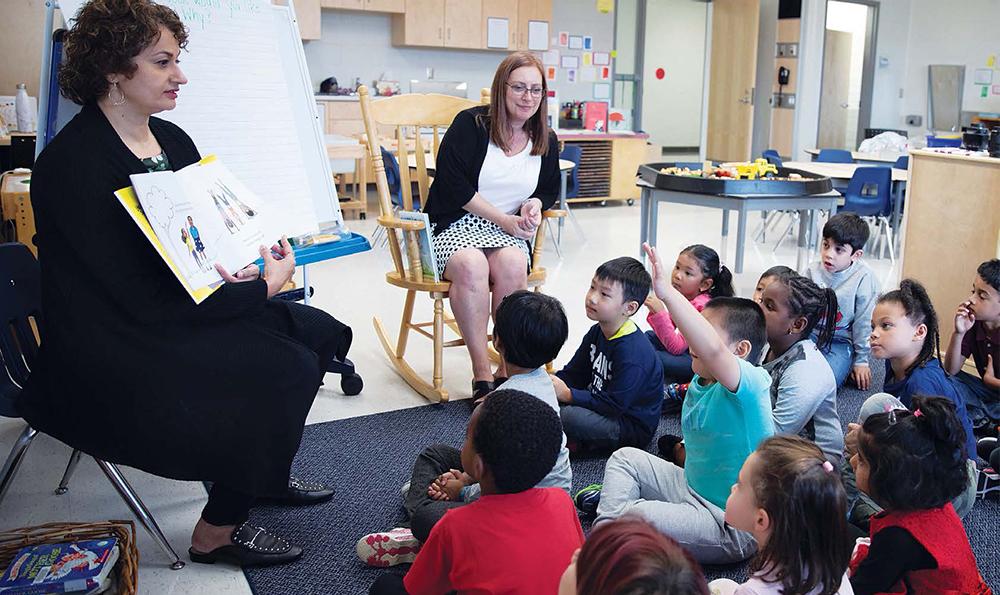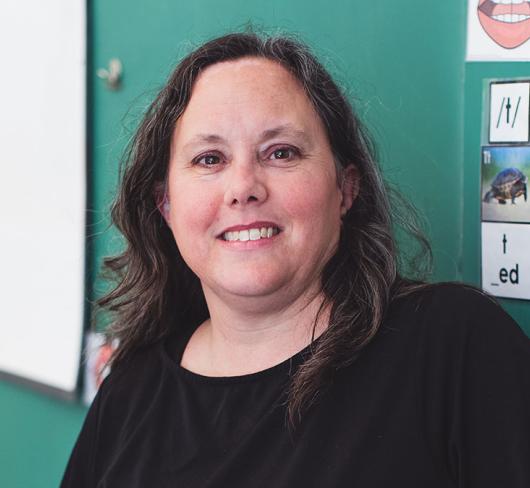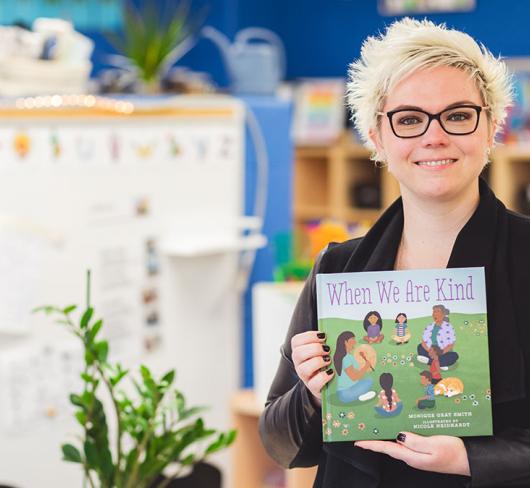
Culturally Relevant and Responsive Pedagogy in The Early Years: It’s Never Too Early!
A few years ago, I was teaching kindergarten in a large community mainly consisting of families who had recently immigrated to Canada. The first day of school, a parent approached me to say they had just arrived from Egypt a few days prior and his son did not speak English. When I leaned down to welcome Omid, he turned away from me and held fast to his father’s hand. I could clearly see the fear and worry in his young face.
For the first few weeks of school, Omid’s transition to his new surroundings presented challenges. When it was time to leave a space or another adult entered the classroom, he became emotional or responded with “no.” He seemed to be looking for opportunities to gain control over his circumstances and the new environment and he would often throw materials or cling to objects that belonged to someone else.
Other educators came to me with strategies such as giving Omid a tablet to calm him down or having him sit out when he was wasn’t listening. But I knew these strategies would not help Omid because his behaviours were not meant to sabotage, they were a sign he was distressed. I needed to figure out the causes of Omid’s distress, who he was and what he needed to be successful.
At first, I thought it would be simple. I too had come to Toronto with my family when I was four and I also did not speak English. Quickly, I learned that this did not make me an expert in what Omid was dealing with. I had to examine the biases and assumptions that limited my understanding of Omid’s lived experiences. Did I assume that Omid would just pick things up based on a dominant narrative? Was I asking him to follow me because I believed that the teacher is the only leader in a classroom space?
Omid’s struggles represent what so many of our students are facing in spaces where they cannot share who they are and, instead, are asked to put their identities aside for compliance. Compliance is not the foundation for student success. In fact, when we focus too much on compliance, students can struggle with how to problem-solve and make decisions independently; they may become anxious in new and unknown situations.
Celebrating who our students are, using their identities to build learning communities and supporting them in understanding their own potential power and privilege are key to academic, social, emotional and physical wellbeing and success. Essentially, this means using Culturally Relevant and Responsive Pedagogy (CRRP) as the basis of our work with students, families and communities.
But how do we do this work? Before we can understand who our students are, we need to be willing to closely examine our personal and professional beliefs about culture, how it is defined by different identities and the role it plays in teaching and learning and the lives of students.
What is the theory behind CRRP? How might it apply in classroom spaces?
CRRP is a research-based pedagogy that has been around for many years and has proven to positively impact family engagement and student achievement. It is not a framework that can be quickly implemented, nor is it a set of lesson plans or activities. It is a shift in how we think about ourselves, students, families and communities and how we use lived experiences and culture to ensure equitable outcomes for all students.
Researchers have described CRRP differently over the years. While Gloria Ladson-Billings (1994) refers to “Culturally Relevant Pedagogy” as “a pedagogy of opposition specifically committed to collective, not merely individual, empowerment,” Geneva Gay (2000) uses the term “Culturally Responsive Teaching” to describe “using the cultural characteristics, experiences and perspectives of ethnically diverse students as conduits for teaching them more effectively.” There are reasons for merging the two to emphasize that “educators must explore how they look at, understand, interact with and engage in meaningful curriculum tied to who is in the classrooms and schools.” (West- Burns, 2018).
As CRRP practitioners, we need to be aware of the three tenets of the practice, as described by Ladson-Billings (1994). When we understand these three tenets, we can consider questions that help to unpack our own biases and assumptions.
High expectations refers to ensuring that high academic expectations are set for all students. While setting these high expectations, educators understand the importance of differentiation, scaffolding and using a variety of assessments to support students as they achieve these expectations.
Some questions to consider:
- Do I set different expectations for groups of students who represent a particular race or identify themselves within a particular gender?
- Do I use a position of power to communicate expectations to students and families?
- When I refer to “those students,” am I setting the bar at a lower level?
- How might the assessments I use limit student success?
Cultural competence means helping students to value their own cultures while learning about the cultures of others who may or may not be represented in their classrooms. In developing cultural competence, educators are learners and do not assume that they know students based on their cultures. They recognize that expertise is distributed among all students.
Some questions to consider:
- What is the dominant culture in the classroom and how do I teach beyond it?
- When we discuss cultural celebrations, are any stereotypes being presented? How can I avoid only talking about food, festivals, fun and folk?
- How do I draw on expertise about cultures in the classroom and community?
Critical consciousness is developed when we challenge students to question, analyze and critique the norms and values that shape society and lead to social inequities for different groups. In this tenet, educators provide opportunities for students to use multiple literacies and digital competencies to solve authentic, real-world problems occurring within local and global communities.
Some questions to consider:
- Do I believe inequity exists?
- How do I provide opportunities for students to question and challenge inequity?
- What privileges might I have? Do students and families have these same privileges?
- How do I bring the world students are part of into the classroom?
How do we define culture?
Understanding the three tenets can lead us to consider the definition of culture. When we think of culture, words such as race, religion and traditions may come to mind. But how might we open the definition to encompass all its aspects? Culture is dynamic and ever-changing, connected to categories we may use to identify ourselves, socially, physically or mentally, such as gender, sexual orientation, financial status, education, social media user, ability and age, to name just a few.
If we broaden the definition of culture, we invite every student and educator to enter spaces to learn and contribute, as well as question why historically certain groups are excluded because they do not fit into narrow definitions created by specific, dominant groups.
The categories we use to identify ourselves intersect and are multi-layered, sometimes self-identified, sometimes attributed to us by others. For example, the “Power Flower” illustrates how complex categories of one’s culture can be, highlighting the relationship between understanding the identities that define one’s culture and how we may experience power, privilege and oppression due to these identities (original concept from Letters to Marcia, Enid Lee, 1985).
For example, you might notice that the dominant group within each category is located on the outer petals. If you were to then shade the petals (inner or outer) that match how you identify yourself, the privileges that you carry can become more apparent.
Doing this exercise is not meant to make us feel guilty for the privileges we have. With privilege comes the power to be an ally to our students and families. We can use privilege to stand beside, behind or in front of those who may not have the same privilege and who may be seeking support.
How can I use CRRP in early years spaces?
The complexity of CRRP, defining culture and examining power and privilege, can lead educators to believe that using CRRP only begins in the intermediate grades when students are old enough to understand such concepts.
But I would argue, it is never too early to begin talking about and exploring enduring understandings around identity, inclusion, lived experiences and power. If we use the early years as the vehicle to engage students in critical thinking and inquiry about these topics, we can change the paths for those who have less power and privilege and build towards allyship and advocacy.
So, what might this look like?
1) Use rich texts as the entry point to discussing student identity.
- Examine the texts that you use for literacy development, such as during read-alouds. What do the characters look like? Do they represent different racial backgrounds and, if so, are they depicted in stereotypical ways? (e.g., the Black character needs to be helped/rescued by someone)
- Invite students to add what is “missing” to the texts you read. (e.g., who could have been included in the story?)
- Co-create texts with students so they can add their first languages or illustrate how they perceive the story.
Integrate Indigenous storytelling as part of a Learning Circle. (aadnc-aandc.gc.ca/)
2) Engage families and the community as partners you can learn from, recognizing that their lived experiences with school and education may be different.
- Open the classroom space to families at a time that is convenient for them. It is not a visit, but an opportunity for families to be included in learning experiences and share what learning looked like for them as children.
- Ask family/community members to come and speak to the students about their experiences. (e.g., what it may have been like to come to Canada if their country of origin is different)
- Offer translated versions of newsletters so all families can access information needed to help their children be successful.
- Co-create high expectations for students with family members and invite them to share how their child learns best and their strengths.
3) Create learning opportunities that celebrate students and the way they learn and think.
- Provide mirrors and ask students, “What do you see?”
- Leave spaces in the classroom that can be co-created with students based on what they identify as “missing” from the room.
- Use open questions to allow students to enter at different points. (e.g., what does peace look like?)
- Offer art materials that reflect a variety of skin colours.
- Use Talking and Listening chairs to allow students the opportunity to problem-solve independently.
4) Plan for intentional learning experiences that develop critical consciousness.
- “Eavesdrop” on students’ conversations and use ideas for springboard to inquiry. (e.g., I once overheard some female students chastising a student for using the colour pink in his artwork because he was a male. This led to an inquiry, “What is a girl’s colour?”)
- Frame curriculum topics as problems to solve. (e.g., in the Grade 2 Social Studies Curriculum, Changing Families and Community Traditions, invite student thinking at learning centres with an open question: “Why are many celebrations influenced by Christmas?”)
- Introduce the concept of “fairness” and encourage students to provide/illustrate examples.
5) Use assessments that focus on student learning and ways to provide feedback.
- Offer students choice as to how they want to share their learning. (e.g., making a video, painting a picture, representing their ideas through building)
- Use pedagogical documentation to make thinking visible, by recording what you see and hear students doing and then analyzing what this means for next steps in learning.
- Make assessment transparent by sharing what you see with students. (e.g., “I noticed that you…this shows that you know how to...now you can…”)
6) Assume that you need to make personal connections with students on a regular basis.
- Conduct student interviews/focus groups to determine how they feel about the classroom and issues of fairness and exclusion.
- Learn words in their first language and add these words to your visual schedule or to oral discussions.
- Ask students to identify what they are good at and create an “expert” wall so they can access support from other classmates.
- Use photographs of students rather than commercially made posters or charts.
Essential for some is good for all
During my own journey to learn more about CRRP, I used some of these ideas with Omid. I invited his parents to drop in when they were available. I created a box of items with his favourite learning tools that he could access whenever he needed. I shared some breathing techniques to help him with self-care. And I listened to him, not just when he spoke, but I listened through observing.
And that is when I “heard” other students and saw the need to expand my definition and use of CRRP to include all students. CRRP does not have to start and end with one student.
Sangeeta McAuley is a member of the Elementary Teachers of Toronto.

